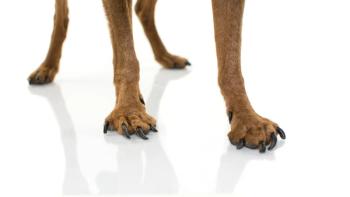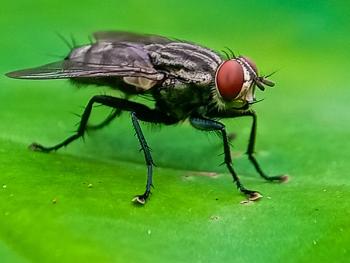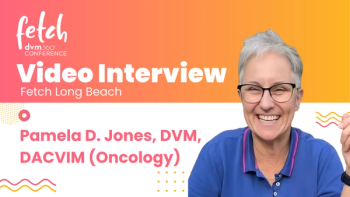
Elevating end-of-life care

How AAHA’s specialty accreditation is raising the standard.
A new era of veterinary hospice and euthanasia care
Veterinary end-of-life care (EOLC) has evolved into a vital specialty within our profession, blending medical expertise with emotional intelligence and deep compassion. For decades, euthanasia was often viewed as a single medical event, rather than part of a comprehensive continuum of care that honors the human-animal bond. Today, more veterinarians are recognizing that how we guide families through this final stage can profoundly influence their healing and trust in veterinary medicine.
This growing awareness has created an increased demand for consistency, training, and standards that ensure patients and families experience care rooted in dignity and compassion. At the same time, veterinarians and teams performing this emotionally demanding work deserve structure, community, and recognition for the unique skills required.
Since 2010, Caring Pathways has led the way in establishing high standards for compassionate, high-quality end-of-life care. When the American Animal Hospital Association (AAHA) introduced the End-of-Life Care specialty accreditation (EOLC accreditation), we were honored to be the first to achieve it—affirming that EOLC practices can and should be recognized for their dedication to excellence in patient care, client support, and organizational integrity.
The history of AAHA and the development of the EOLC accreditation
AAHA began in 1933 from a small group of veterinarians who had a vision to elevate the standard of care in veterinary medicine.AAHA is the only accrediting body in North America and prides itself on a strong foundation rooted in community and an elevated standard of care for veterinary excellence. To date, AAHA has grown to over 4,500 accredited practices and we aim to continue our mission and vision every day.
To become AAHA-accredited means your practice and team voluntarily go through an evaluation process that encompasses 46 mandatory standards and over 900 standards that span over 19 sections. AAHA’s standards of care surround best practices in pain management, patient care, continuing education, leadership, and medical records, for starters.
AAHA accreditation means practices go above and beyond to uphold a high standard of excellence not only within the walls, or vehicles, of a practice, but also outside with the veterinary community. AAHA helps our members continue to advocate for our patients and constantly reminds us of the why behind what we do.
About 5 years ago, End of Life Care accreditation began as a center of excellence that an accredited practice could strive for during their evaluation. From there, it grew to become AAHA’s first separate accreditation model outside of traditional accreditation. Within end-of-life care specifically, there are 21 mandatory standards and 16 sections of standards.
AAHA wants to continue to shed light on this aspect of patient care that does not carry the focus it should. We plan to continue to ensure this accreditation remains a focus in the veterinary community.
What it takes: Inside the AAHA EOLC accreditation
A key component for this accreditation is a willingness and a desire to continue to grow and learn outside your comfort zone relating to end-of-life care. This accreditation requires you to deepen your knowledge surrounding your communication and active listening skills.
This accreditation allows you to remove our personal judgement and advocate for patients in a much greater capacity. It is more than a focus on euthanasia, but hospice and palliative care advocacy as well.
There are 3 sections that come to mind for starters: Continuing education, medical records, and patient care. The continuing education section helps provide industry-wide resources to elevate your team's compassionate skills while the medical records and patient care sections offer a plethora of standards to help practices begin to build useful hospice and palliative care and euthanasia templates. They help practices see above and beyond to identify necessary caregiver lines in the sand and goals for their pet.
Veterinary practices are already seeing chronic pain management cases, geriatric cases, quality of life cases, and more, so why not allow the EOLC accreditation to help you and your team create a truly individualized and patient-centered approach to care?
Implementation in the real world and raising the bar
Caring Pathways was among the first organizations to pursue and achieve AAHA’s EOLC accreditation across all of our markets. As a company dedicated exclusively to hospice and in-home euthanasia services, we saw this as both a validation of our mission and an opportunity to refine how we serve families, support our teams, and model best practices for the profession.
The process was comprehensive and introspective. Our teams evaluated every aspect of care—from communication and pain management protocols to grief resources and team support. While the standards were rigorous, they ultimately reinforced the systems we already valued: empathy-driven communication, continuous education, and team wellness. Going through the accreditation unified our markets under a shared framework of excellence and created meaningful conversations about how to maintain compassion while pursuing consistency and quality at scale.
For our doctors and client care teams, accreditation provided a renewed sense of pride and purpose. It underscored that end-of-life care is not a niche service—it is a cornerstone of the veterinary profession’s responsibility to the human-animal bond. Families benefit, too. Accreditation offers them reassurance that the care they receive meets the highest possible standards, both medically and emotionally.
This model also invites general practices to partner confidently with accredited EOLC providers, knowing their patients will receive care consistent with AAHA’s standards. These collaborations help primary care veterinarians maintain continuity for families while ensuring that end-of-life support is handled with the expertise and compassion this delicate time deserves.
At Caring Pathways, we believe AAHA’s EOLC accreditation is helping to elevate the profession by setting a precedent that compassionate care can and should coexist with clinical excellence.
What practices can do today
For practices that are already AAHA-accredited, you can find the EOLC accreditation standards available for download on the aaha.org website. Should you wish to explore applying or ask any questions, simply contact your accreditation pairing, also located on our website.
There are also wonderful Promise posters available via the website as well; if accredited, simply navigate to the Publicity toolbox and select whatever design you wish. We’ve also created special end-of-life care accredited posters for the elite end-of-life care accredited members, complete with personalized, helpful hospice and palliative care tutorials and grief counseling resources for your clients.
They say senior dogs and cats represent 44% of the pet population1. We know that end-of-life care can happen at any age, however, start by focusing on your senior patients. How can you make a lasting impact on their lives and caregivers?
Integrating end-of-life care in your practice is not as difficult as you would think! Consider the following tips and ask your team their why behind the patient care you already provide:
- Can you focus more on improving your euthanasia? Reflect on what went well or what could have gone better.
- While it is not mandatory to have a dedicated comfort room, ask yourself how you would go above and beyond to make them feel comfortable in their most vulnerable time.
- What encompasses your euthanasia caddy?
- What tools are currently at your disposal that could be enhanced, for instance, quality of life scales, disease trajectory resources, daily health logs, mental health & grief support resources.
- Can you implement a rating system or perhaps enlist a dedicated euthanasia attendant? If you could create an end-of-life care manual, what would you want it to include?
- Remember to showcase this special aspect within your practice. Is it present on your website? Could you have a senior muzzle parking space?
Embrace your practice’s creativity and uniqueness and I guarantee you they will surprise you! Remember, age is inevitable, so let’s help make it as healthy and special as possible.
There are a plethora of wonderful resources pertaining to end-of-life care out there. AAHA has one directly at your fingertips via AAHA Learning: AAHA’s End of Life Care Certificate Program. This extensive, online 14-module course is divided into 3 parts:
- Introduction to AAHA/IAAHPC End of Life Care Guidelines
- Euthanasia and Hospice Services
- End of Life Care Palliative Care in Practice
Kathleen Cooney, DVM, MS, CHPV, CPEV, DACAW, provides an amazing roadmap and outline for anyone interested in expanding their knowledge surrounding end-of-life care. We highly recommend it!
We also recommend searching for a program or event that suits you best. The best way to become more comfortable in this space is by jumping in with both feet, I promise you will become humbled and illuminated in a way you never thought possible.
Anyone interested in learning more about the AAHA End of Life Care Certificate Program can learn more on the AAHA
Reference
- 2023 AAHA Senior Care Guidelines for Dogs and Cats. American Animal Hospital Association. December 12, 2022. Accessed November 3, 2025.
Newsletter
From exam room tips to practice management insights, get trusted veterinary news delivered straight to your inbox—subscribe to dvm360.




